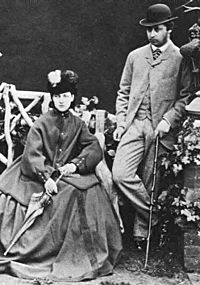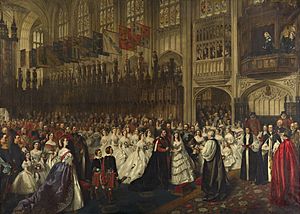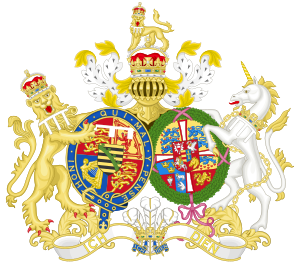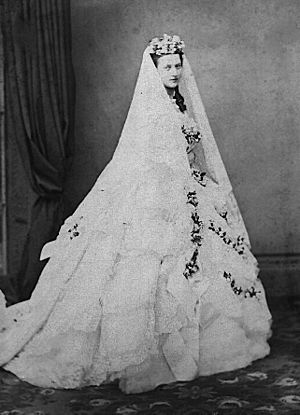Wedding of Prince Albert Edward and Princess Alexandra facts for kids

Prince Albert Edward and Princess Alexandra on their wedding day, 1863
|
|
| Date | 10 March 1863 |
|---|---|
| Venue | St. George's Chapel, Windsor Castle |
| Location | Windsor, England |
| Participants | Albert Edward, Prince of Wales (later King Edward VII) Princess Alexandra of Denmark (later Queen Alexandra) |
The wedding of Albert Edward, Prince of Wales (later King Edward VII), and Princess Alexandra of Denmark (later Queen Alexandra) took place on 10 March 1863 at St. George's Chapel, Windsor Castle. It was the first royal wedding to take place at St. George's, and the last wedding of a prince of Wales until Prince Charles and Lady Diana Spencer's 1981 wedding. Albert Edward became King Edward VII in 1901.
Contents
Engagement
Before his marriage, Prince Albert Edward, known as "Bertie" amongst his family, garnered a reputation as a philandering prince, and his irresponsibility was greatly detested by his parents, Queen Victoria and Albert, Prince Consort. They sought to put a stop to his affairs by means of marriage and thereby bring stability to his life. In 1858, the Queen and Prince Albert began the process of finding their son a suitable bride, preferable a German Protestant. The Prince's older sister, Victoria, Princess Royal (by then Crown Princess of Prussia), aided the Queen in drafting a list of potential brides, the fifth on the list being the thirteen-year-old Princess Alexandra of Denmark, the eldest daughter of Prince Christian of Schleswig-Holstein-Sonderburg-Beck (later King Christian IX of Denmark) and Louise of Hesse-Kassel. In the end, Bertie's father agreed on Alexandra, remarking that she was "the only one to be chosen." Prince Albert Edward and Princess Alexandra met on 24 September 1861 at Speyer Cathedral, Germany, an arrangement engineered by Princess Victoria.
On 14 December that year, Prince Albert died of typhoid, causing the Queen to enter a deep state of mourning. She blamed his death on their son and his affairs, most recently with actress Nellie Clifden that caused a rift between Bertie and his father. Perhaps to appease his mother by following the late Prince Consort's wishes, Bertie proposed to Alexandra on their next meeting. They were engaged on 9 September 1862 at the Palace of Laeken, Belgium.
Princess Alexandra arrived in Britain abroad the royal yacht Victoria and Albert on 7 March 1863, just a few months after the engagement. She was received by large crowds as she landed in Gravesend, Kent. She joined the Prince of Wales on the royal train for the journey to London, where she was greeted by an anxious Queen Victoria.
Wedding
The Queen decided that the ceremony would be held at St. George Chapel, Windsor, at the time an unusual location as royal weddings typically took place in London. The press complained that public spectators would not be able to view the event. Some people who might have expected invitations were disappointed that the event was planned to be small, and therefore they did not receive invitations. Only Princess Alexandra's close family were invited.
On the morning of 10 March 1863, the carriage procession began from Windsor Castle. The Danish royal family were first, followed by the British royal family members; the Prince of Wales and his entourage were in the next-to-last carriage, with the bride coming last. Queen Victoria was not part of the procession, being taken to the chapel privately. She was escorted by her brother-in-law, the Duke of Saxe-Coburg and Gotha; she was dressed in mourning, and viewed the ceremony from above and out of view of the other guests. The ceremony was conducted by Thomas Longley, the Archbishop of Canterbury.
Princess Alexandra was attended by eight bridesmaids Diana Beauclerk, Victoria Montagu-Douglas-Scott, Victoria Howard, Elma Bruce, Agneta Yorke, Emily Villiers (filling in for Hariot Georgina Hamilton-Rowan who was indisposed that day), Eleanor Hare and Feodorowna Wellesley. She was supported by her father, Prince Christian, and by the Duke of Cambridge. The Prince of Wales was supported by his uncle, the Duke of Saxe-Coburg and Gotha, and brother-in-law, the Crown Prince of Prussia.
After the ceremony, the Prince and Princess of Wales returned to Windsor Castle along with the other guests. Many of the royal guests served as witnesses, with Queen Victoria, the Prince of Wales's siblings and their spouses, Princess Alexandra's family, as well as the Danish and British ministers and Lord Chancellor signing the marriage register. A banquet was held in the State Dining Room for the royal guests and in St. George's Hall for household members, and other guests. The couple honeymooned at Osborne House on the Isle of Wight.
Following her marriage, Princess Alexandra was styled Her Royal Highness The Princess of Wales.
Wedding dress
The wedding dress of Princess Alexandra of Denmark was made by London dressmaker Mrs James of Belgravia, and was the first British royal wedding dress to be photographed while being worn.
Guests
Groom's family
- The Queen, the groom's mother
 The Crown Princess and Crown Prince of Prussia, the groom's sister and brother-in-law
The Crown Princess and Crown Prince of Prussia, the groom's sister and brother-in-law
 Prince Wilhelm of Prussia, the groom's nephew
Prince Wilhelm of Prussia, the groom's nephew
 Princess and Prince Ludwig of Hesse and by Rhine, the groom's sister and brother-in-law
Princess and Prince Ludwig of Hesse and by Rhine, the groom's sister and brother-in-law- The Princess Helena, the groom's sister
- The Princess Louise, the groom's sister
- The Prince Arthur, the groom's brother
- The Prince Leopold, the groom's brother
- The Princess Beatrice, the groom's sister
 The Duke of Saxe-Coburg and Gotha, the groom's paternal uncle
The Duke of Saxe-Coburg and Gotha, the groom's paternal uncle- The Duchess of Inverness, the groom's maternal grandaunt by marriage
- The Duchess of Cambridge, the groom's maternal grandaunt by marriage
- The Duke of Cambridge, the groom's maternal first cousin once removed
- Princess Mary Adelaide of Cambridge, the groom's maternal first cousin once removed
- The Prince of Leiningen, the groom's maternal first half-cousin
- Prince and Princess Victor of Hohenlohe-Langenburg, the groom's maternal first half-cousin and his wife
 The Duchess of Brabant, wife of the groom's double first cousin once removed
The Duchess of Brabant, wife of the groom's double first cousin once removed The Count of Flanders, the groom's double first cousin once removed
The Count of Flanders, the groom's double first cousin once removed Prince August of Saxe-Coburg and Gotha, the groom's double first cousin once removed
Prince August of Saxe-Coburg and Gotha, the groom's double first cousin once removed
Bride's family
 Prince and Princess Christian of Denmark, the bride's parents
Prince and Princess Christian of Denmark, the bride's parents
 Prince Frederick of Denmark, the bride's brother
Prince Frederick of Denmark, the bride's brother Prince Wilhelm of Denmark, the bride's brother
Prince Wilhelm of Denmark, the bride's brother Princess Dagmar of Denmark, the bride's sister
Princess Dagmar of Denmark, the bride's sister Princess Thyra of Denmark, the bride's sister
Princess Thyra of Denmark, the bride's sister
- The Duke of Schleswig-Holstein-Sonderburg-Glücksburg, the bride's paternal uncle
 Prince Frederick William of Hesse-Kassel, the bride's maternal uncle
Prince Frederick William of Hesse-Kassel, the bride's maternal uncle
Other royals
 Prince Edward of Saxe-Weimar
Prince Edward of Saxe-Weimar- Maharaja Sir Duleep Singh
Foreign ambassadors
 The Ottoman Ambassador and Madame Mousouros
The Ottoman Ambassador and Madame Mousouros The Austrian Ambassador and Countess Apponyi
The Austrian Ambassador and Countess Apponyi The Russian Ambassador and Baroness von Brunnow
The Russian Ambassador and Baroness von Brunnow The Prussian Ambassador and Countess von Bernstorff
The Prussian Ambassador and Countess von Bernstorff The French Ambassador
The French Ambassador The Belgian Minister and Madame Van De Weyer
The Belgian Minister and Madame Van De Weyer The Bavarian Minister
The Bavarian Minister The Hanoverian Minister
The Hanoverian Minister The Italian Minister
The Italian Minister The Dutch Minister
The Dutch Minister The Portuguese Minister
The Portuguese Minister The Brazilian Minister and Madame Moreira
The Brazilian Minister and Madame Moreira The Saxon Minster
The Saxon Minster The Danish Minister
The Danish Minister The Honduran Minister
The Honduran Minister The United States Minister and Mrs. Adams
The United States Minister and Mrs. Adams The Swedish Minister
The Swedish Minister The Spanish Minister
The Spanish Minister The Peruvian Minister
The Peruvian Minister The Persian Minister
The Persian Minister The Greek Chargé d'affaires
The Greek Chargé d'affaires The Haitian Chargé d'affaires
The Haitian Chargé d'affaires
Royal household
- The Lord Steward
- The Lord Chamberlain and the Viscountess Sidney
- The Master of the Horse and the Marchioness of Ailesbury
- The Mistress of the Robes
- The Treasurer of the Household and Viscountess Bury
- The Comptroller of the Household and Lady Proby
- The Vice Chamberlain and Viscountess Castlerosse
- The Captain of the Yeomen of the Guard and the Countess of Ducie
- The Gold Stick in Waiting and Viscountess Combermere
- The Keeper of the Privy Purse and the Hon. Lady Phipps
- The Master of the Buckhounds and the Countess of Bessborough
- The Deputy Earl Marshall
- The Master of the Household and the Hon. Mrs. Biddulph
- The Lord in Waiting
- The Groom in Waiting
- The Clerk Marshal
- The Groom of the Stool and the Countess Spencer
- The Lord Chamberlain to the Princess of Wales
Clergy
- The Archbishop of Canterbury
- The Bishop of London and Catharine Tait
- The Bishop of Winchester
- The Bishop of Oxford
- The Bishop of Chester and Mrs. Graham
- The Dean of Windsor and the Hon. Mrs. Wellesley
Politicians
- The Lord High Chancellor
- The Lord President of the Council
- The Lord Privy Seal and the Duchess of Argyll
- The Prime Minister and First Lord of the Treasury, and the Viscountess Palmerston
- The Chancellor of the Exchequer and Mrs Gladstone
- The Secretary of State for Foreign Affairs and the Countess Russell
- The Secretary of State for the Colonies
- The Secretary of State for the Home Department and Lady Grey
- The Secretary of State for India and Lady Mary Wood
- The Secretary of State for War
- The First Lord of the Admiralty and the Duchess of Somerset
- The President of the Board of Trade
- The Postmaster General and the Lady Stanley of Alderley
- The Chancellor of the Duchy of Lancaster and Mrs. Cardwell
- The President of the Poor Law Board
- The First Commissioner of Works and the Hon. Mrs. William Cooper
- The Vice-President of the Committee of the Council on Education and Mrs. Lowe
- The Vice-President of the Board of Trade and Mrs. Hutt
- The Chief Secretary for Ireland
- The Speaker of the House of Commons and Lady Charlotte Denison
- The Lord Chief Justice of the Queen's Bench
- The Judge Advocate General and Mrs. Headlam
- The Adjutant General
- The Quartermaster General
- The Lord Mayor and Lord Mayoress of London
- The Gentleman Usher of the Black Rod
- Mr and Mrs. Benjamin Disraeli
Nobles
- The Duke and Duchess of Buccleuch
- The Duke of Devonshire
- The Duke of St Albans
- The Dowager Duchess of Sutherland
- The Duke and Duchess of Atholl
- Marquess and Marchioness of Carmarthen
- The Marquess and Marchioness of Salisbury
- The Marquess Camden
- The Marquess and Marchioness of Abercorn
- The Marquess and Marchioness of Westminster
- The Marchioness of Ely
- The Dowager Countess of Mount Edgcumbe
- The Earl and Countess of Mount Edgcumbe
- The Earl and Countess of Clarendon
- The Earl and Countess of Suffolk
- The Earl and Countess of Hardwicke
- The Earl and Countess Cowley
- The Earl and Countess of Macclesfield
- The Earl and Countess of Morton
- The Earl and Countess de Grey and Ripon
- The Earl of Carlisle
- The Earl of Harrowby
- The Countess of Derby
- The Earl and Countess of Shaftesbury
- The Earl and Countess Fitzwilliam
- The Earl and Countess De La Warr
- The Earl and Countess of Caithness
- The Viscount and Viscountess Falkland
- The Countess of Dysart
- Viscount Hinchingbrooke
- Viscountess Jocelyn
- Viscountess Chewton
- Viscountess Forbes
- The Viscount and Viscountess Torrington
- The Lord Portman
- The Lord and Lady Churchill
- The Dowager Lady Lyttelton
- The Lord and Lady Camoys
- The Lord Rivers
- The Lord Methuen
- The Lord and Lady de Tabley
- The Lord and Lady Cremorne
- The Lady Byron
- Lord and Lady Alfred Harvey
- Lord Charles FitzRoy
- Francis and Lady Emily Seymour
- The Hon. Dudley and Lady Elizabet de Ros
- Sir William Alexander, 3rd Baronet
- Sir Alexander Cornewall Duff-Gordon, 3rd Baronet
- Sir William Dunbar, 7th Baronet and Lady Dunbar
- Sir James Clark, 1st Baronet
- The Garter Principal King of Arms





